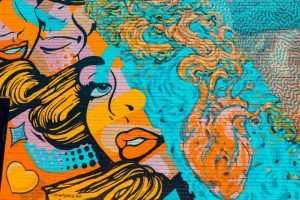Today 3D art is a vibrant part of the art world, and its impact is growing each year. In galleries and museums worldwide, artists are using the third dimension to create works that are as compelling as they are innovative.
With increased access to powerful software like 3D Studio Max and Cinema 4D, it has never been easier for artists to experiment with 3D forms. And galleries and museums have quickly begun to capitalize on this new technology by organizing special exhibitions in which sculpture, video, and animation are presented in engaging new and creative ways.
Rather than being just another addition to the ever-expanding category of digital art, however, 3D art distinguishes itself from other forms by drawing on the traditions of fine arts such as painting and sculpture. If you’ve ever looked at a painting, sculpture or drawing and wondered what it would look like if you could walk around it or peer inside it, then you already have an idea of what 3D art is about.
The term “appropriation” refers to a process in which an artist takes something that already exists—a photograph, a commercial image, a found object—and re-uses it as the basis for an original work of art. Appropriation artists often use existing images because they are familiar to viewers
Art appropriation is an artistic movement that appropriates existing objects and images. The goal of this art form is to take a famous piece of art and recreate it in 3D form, giving it a new life as a different medium, remodeled in the artist’s vision.
The most important thing when creating appropriation art is to make sure your end product looks real. If people can’t tell what you’ve created is an object and not the original, then you have failed to accomplish your goal of creating appropriation art. You may be using the same colors or shapes as the original artist but if your piece doesn’t look realistic then you have failed.
You can use different types of media for this project, but the most commonly used mediums are clay and polymer clay. Polymer clay is popular because it is easy to use and gives high quality results. It can also be used on a larger scale than clay so artists can make bigger pieces with more detail and color.
Another important detail when making 3D art out of an image or object is making sure that it isn’t too big or too small compared to the original piece. If your creation is too small then it will look like nothing more than a doll made out of play-doh while if your creation is too
Appropriation art, a form of fine art in which artists re-use material created by other artists, is not a new concept. It was recognised as an artistic genre at least as early as 1899 by the critic Bela Gajewsky, who described it as “the taking over of alien forms and contexts.” In the following decades, appropriation art became widely accepted in the USA and Europe, with examples including Man Ray’s 1923 work
Appropriation art is a term used to describe works of art that appropriate the visual language and styles of other artists. Appropriation art is often used to critique the original artist and the meaning behind their work.
Appropriation art can be found in graphic design, movies, advertisements, and even music. The use of appropriation art is not reserved for fine arts; it can be found in almost all areas of media.
Appropriation art was a revolutionary movement during the late 1960s, when it began its presence in various galleries throughout Europe and America.
Appropriation art is still very popular today. It is an easy way to create something beautiful and new, while at the same time critiquing society.
“The best way to create something new is to use what already exists and make it your own.” – Charles Mingus
Artists have always been inspired by art that came before them. We look at the work of the past and learn from it, we look at the work of others and are inspired to be creative. This is how art has always progressed, but what happens when artists no longer want to just look at art from the past? They want to take it and make it their own. This idea is called “Appropriation Art”.
This was a movement that started in the 1960’s. The artists involved were interested in making new art out of pieces of other artists’ works or historical images. The idea was that they would take something old and already known and make it into something new. They didn’t want to simply copy existing images they wanted to change them in some way or combine them with other images to create something fresh.
This movement was fueled by a lot of political and social factors. The general feeling at this time was that there needed to be a change in society, art, etc. There was perceived as being too many old ways or traditions still around. Artists felt like they couldn’t be as expressive as they wanted due to censorship or
Appropriation art is an integration of several artistic disciplines and styles to create a single new work. The term appropriation originates from a description of collage as the “art of taking” or “stealing” fragments from different places and combining them into one new entity. It has been used by critics of the medium since at least the 1940s, but it was not until the late 1960s that artists considered themselves appropriators as well. The term was popularized in the 1980s due to its use by critics to describe artists such as Sherrie Levine, Richard Prince, Cindy Sherman, and Jeff Koons.
Tate Online’s definition of appropriation reads: “a method of creating art in which the artist takes images and objects from a variety of sources, including mass media, advertising and photography, and combines these with original elements to create a new meaning.” In addition to being an integral movement within Pop Art, Appropriation also has ties to Dada and Surrealism.
Description:
Appropriation is often used synonymously with collage, a technique in which one uses materials from diverse sources to create a new work. However, appropriation differs from traditional collage in that it does not include an element of chance; all appropriated elements are carefully chosen
Over the past decade or so, largely due to the work of Duchamp and Warhol, art has become increasingly focused on appropriation. This is a type of art where the artist takes works from other mediums, such as film or music, and incorporates them into their own artwork. These works are designed to be in conversation with one another, to inspire the viewer to think about the meaning behind both pieces.
Hip-hop culture has its roots in this idea of appropriation. Hip-hop has always been about mixing different sounds and different cultures together to create something new that speaks to a generation. The history of hip-hop is essentially one long chain of artists appropriating things that have come before them and building off them to make something new and exciting.
Nowadays we call this “mash-ups”. The hip-hop scene was essentially built on sampling music from other artists and using it as the background for their own work. This is done because it allows artists to create something that would not otherwise exist without having to worry about getting permission or paying royalties. Hip-hops mash ups are often used as a way to critique society in general or even specific people or institutions within society, which is why they have caused such controversy at times within the hip hop



